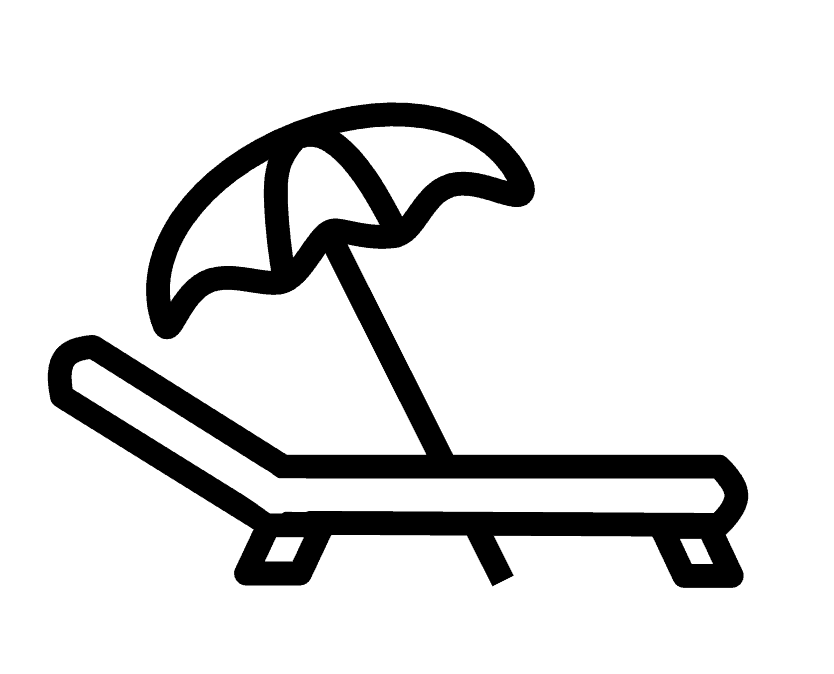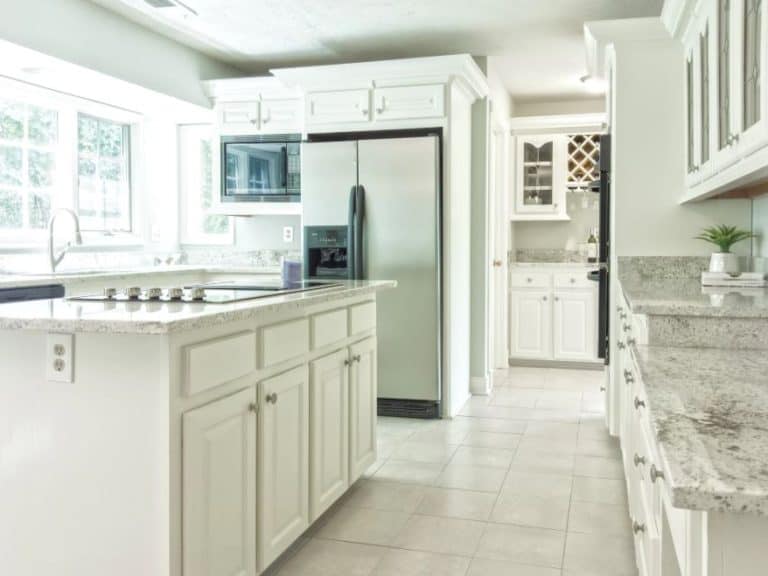Your Umbrella blowing away can be a disaster for your Al Fresco meal but even worse it can become a dangerous weapon with lots of sharp pointy bits just waiting to stab people. They can also be expensive if they break!
With paying guests we are always extra careful to avoid any accidents, so before buying some new Pool / Patio Umbrellas I did some research. Wanting to stop them from blowing away is a given and the most common solution is adding more weight to the base, but as I discovered there are also a number of alternative methods, not just piling it high with weight! Check your Base Weight to Canopy size below.
Disclosure: There are affiliate links within this article, and at no extra cost, I earn a commission if you buy.
How to Stop an Existing Patio Umbrella from Blowing Away – Right Now!
Alternatively, jump straight to:
Initial Setup Checks
- Ensure that the umbrella is presenting the lowest possible profile to the wind.
- Avoid tilting the canopy when it is windy as this increases the area that is presented to the wind.
- If possible make the canopy as low as is practical; some two-part posts can be lowered within themselves.
- Ensure that the umbrella is attached tightly to the base.
- Most bases come with a locking screw (California Style) or a clamping ring and it is really important that it holds the umbrella firmly. You should not be able to twist, rock or lift the umbrella without also moving the base in the same way. One common issue is when using a smaller umbrella post in a large base tube. Single screw base versions often still allow the umbrella to rock as it pivots around the locking screw. See Further Tips Below- How to Stop Umbrella Post from Spinning.
Adding Weight to the Umbrella Base
It is possible to simply add any form of weight to help improve the Stability of your base. The key thing is to make sure it will stay on the base and will not then impact on the use of the umbrella. Balancing some bricks may work for a while but in a breeze, the umbrella will vibrate and such a setup may then move or fall off.
(If you have nothing else to hand, then threading one of the holes in a cinder block over the base tube can keep the block in place! As a temporary measure or course!)
Hollow Base Style
Many base designs, particularly for smaller umbrellas use hollow plastic bases that are designed to be filled with water. These bases can be made heavier by replacing the water with sand. It is worth noting you can increase the weight even further by then making the sand wet! I found that I could add over 5 liters (an additional 5 Kg / 11Lbs) of water to our completely sand-filled bases.
To take it even further you could fill the base with concrete but this obviously changes it from being something you can move easily by changing its weight. I have also had problems with plastic coated concrete bases chipping when not handled with care.
Note: These bases may not have been designed for the extra weight and as such, any lifting or wheel mechanisms should be used with care.
Using Sandbags
The best method is by adding sandbags. When used with wet sand they add a lot of weight for there size but unlike a heavy metal weight, they can be moved in smaller quantities and will not damage anyone or thing if accidentally dropped or kicked. They also conform to the shape of the base and if required can be stacked on top of one another.
There are numerous heavy-duty bags available (see Weights to add to your Base below) but it is also possible to make your own.
Tying It Down
I found a few different comments suggesting tying down your umbrella using various combinations of bungee cords and tent guy lines to get the lines tight. They have then been tied to anything to hand (fences, door hinges, etc) or to custom weights like mini sandbags.
If you are located in a suitable area then there is also an array of different stakes that could be hammered or corkscrewed into the ground to attach to.
NOTE: I have two areas of concern for this method, that have stopped me from using it.
- Where to attach the line to the umbrella without causing damage? If you attach your tie-down line to the end of one of the ribs you are going to be putting significant load on that one rib alone. The canopy design usually works to distribute the loads across all of the ribs. You also have the potential to damage the rib or the canopy where the line attaches.
- Adding a number of tripping or garotting hazards! With guests and young children, I do not like the idea of having lines strung across the areas.
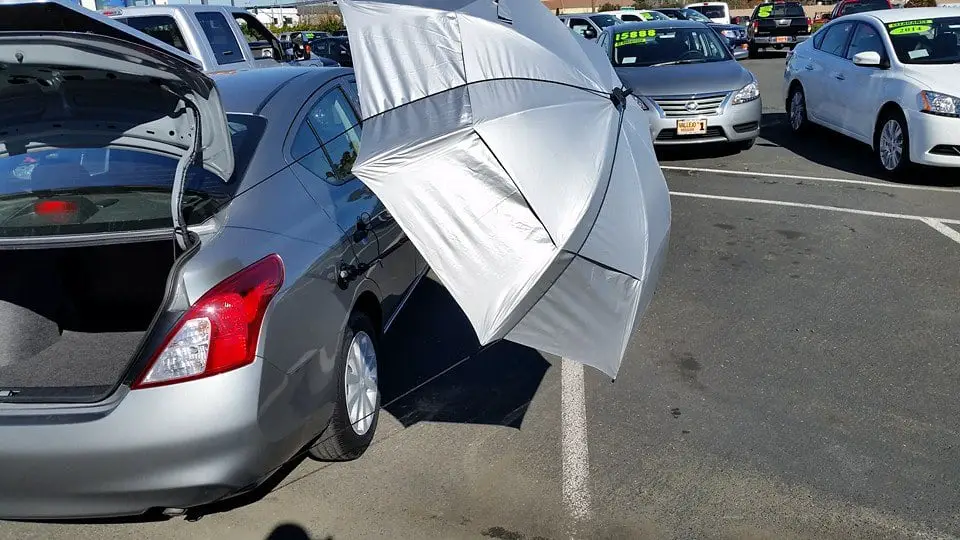
The best version I have found was by Mobiletech Shade, for a commercial car umbrella where the lines come from a central ring that is hooked over the finial at the top of the umbrella. This would not be big enough for most patio umbrellas but the concept might be replicated.
Further suggestions below require a new purchase but you don’t have to replace everything!
In most cases changing the base is enough.
Buying New: How to Choose a Patio Umbrella and Stop it from Blowing Away!
Umbrella bases; what to look for?
The most overlooked aspect when purchasing a new patio umbrella is the base and yet, as explained above, the size and design can be the difference between enjoying a cooling breeze on a hot day and picking up the pieces after a runaway disaster.
What to look for:
- Weight to canopy size ratio; the heavier the better.
- Footprint dimensions of the base; the wider the better.
- Size of the base tube; the taller the better but with the same dimensions as the post.
- Method of attaching to Umbrella Pole; needs to be very secure so multiple points are better.
Base Weight to Canopy Size
Most Freestanding Umbrellas do not come with a base so making sure you buy one of a suitable size is critical. For Cantilever style umbrellas they usually do come with a base frame (T-shaped or a Cross) that is proportional to the size of the umbrella. These base frames do not include the required weight! If they give you no other guidance then usually assume that the frame is designed for concrete paving slabs which are ~65lbs / 30Kg and in most cases they require 4.
These are gathered from a number of internet resources that talk about the problems of Umbrellas falling over due to lack of weight:
| 6ft / 1.8m or less | 30lbs / 13.5 Kg |
| upto 9ft / 2.7m | 50lbs / 23 Kg |
| upto 12ft / 3.7m | 90lbs / 41 Kg |
| Over 12ft diameter | Recommend using a Cantilever style base where weights can exceed 150lbs / 68Kg |
Footprint dimensions of the base
The wider the dimensions of the base the more stable it will be.
In most cases, having decided the weight required for your umbrella size, the dimension of the base is going to be an aesthetic decision. The base material, its design, where it is to be used (under a table or freestanding) and how it fits in with your patio will then limit your choices. You should then choose the base with the widest footprint, to give the greatest stability.
If you are looking at standard ‘Market’ style umbrellas then don’t forget to consider using the bases usually designed for the Cantilever umbrellas. Due to the offset nature of these, they tend to have larger bases to counterbalance the canopy.
Size of the base tube.
For the umbrella to be secure in the base (you should not be able to twist, rock or lift the umbrella without also moving the base in the same way) you want the diameter of the base tube to match that of your umbrella pole and to be as long as possible.
Many of the bases will be designed for a specific umbrella and will have a base tube diameter of anything from ~1″ (2.5cm) up to 3″ (~7.5cm). The usual sizes are 1.75″ or 2″. Ideally, your pole will be less than 0.25″ smaller than the tube. Reducers are available to allow the smaller diameter poles to be used in the larger diameter bases. These cones / wedge (Amazon link) will also help support the umbrella pole where it passes through a table that has an oversize hole.
Some bases have a self-centering collar at the top of the base tube, similar to a reducer, that holds the pole in the middle. This is considered better than the ‘California’ style bases that simply have a locking screw that holds the pole by ‘screwing’ it to one side of the base tube. Particularly for smaller poles in oversized base tubes, the ‘California’ style can let the umbrella rock or spin which should be avoided.
The longer the Base tube the more support it offers to the pole and makes it easier to attach firmly. It also helps if you should use the umbrella pole as a lever when tilting the base to move it, although this is not recommended!
Method of attaching to the Umbrella Pole
Having a large, heavy base will not stop the umbrella blowing away unless it is firmly attached. In most residential examples this is done either by a screw collar that constricts onto the pole at the top of the base tube or by means of a locking screw. For the larger, heavier bases they may even have two locking screws and on some larger commercial umbrellas, they have a pin that passes through the base and the pole.
MY RECOMMENDATIONS
Disclosure: These are affiliate links, and at no extra cost, I earn a commission if you buy.
Wide diameter bases
The steel plate base by Tropishade (Amazon Link) is great at 36lbs as they have a 19 3/4″ x 19 3/4″ base. This style has rubber feet in the corner that can be removed to make it really low profile for use under a table. These designs are also very easy if you do want to add further weight.
The Abba Patio Base (Amazon Link) is even better (but also more expensive) as it is slightly wider at 24″, is heavier at 53lbs and has wheels to help you move it around. It also comes with two different base tube sizes to suit your umbrella and two locking screws.
Reducer – Stop Pole tilt when base tube too large
Ideally, you buy a base that matches the umbrella pole size but these will help if either, you are not buying both new or your umbrella is for a table.
Frequently the hole through a table is made oversize to ensure any size of umbrella pole will fit but that can mean that the pole is free to sway around. Any movement is bad news for stability so by adding a Cone / wedge (Amazon Link) where the pole passes through the table you can stop this. Just make sure you buy the correct cone to match your pole diameter.
Weights to add to your Umbrella base
I like the idea of these Rhino (Amazon Link) sandbags for extra weight. They will be much more friendly for moving than the plastic versions and when not in use (winter storage) they will stow away nice and small. They allow you to load up an extra 90lbs.
My only concern is one of the advertising photos shows them being used for a cantilever base on there own. Most cantilever bases should have flagstones or special-shaped weights (Amazon Link) that fit within there cross design and these sandbags should be used as EXTRA weight not a replacement.
Fixed Base Mounts
The ultimate protection for a falling over umbrella is to have a mount that cannot move! This obviously has the restriction of not allowing you to move the umbrella but offers a lot of confidence for its stability and avoids the need for moving heavyweights or buying a base, especially if you only use it in one place.
There are a few different varieties that can be concreted into place and then have a flap cover that you open to then insert the parasol. These are great as when not in place the surface is flat and clear of any obstructions.
There are also those that allow you to bolt the base tube (with no weight) directly to the surface. The problem is that they will always be sticking up whereas the one above leaves a flat surface. The other issue mentioned in some reviews is the fixings need to be really secure and certainly for larger umbrellas the tube needs to be very strong but no different from other base tubes.
This one from J and C Brands (Amazon Link) is for attaching it to a railing.
Patio Umbrellas – With Vents
Where the choice of base is mainly around the stability of your patio umbrella the choice for the actual umbrella depends on its intended use and therefore shape, size, and style. Two of my favorites having considered their reviews are:
The Abba Patio 9ft Aluminium Market Umbrella (Amazon Link). It gets a good recommendation from The Spruce as well as Amazon and with the vented canopy offers good value. Being Aluminium it is not a forgiving (but much cheaper!) as Fiberglass if it should fall over but shouldn’t happen a suitable base!
The Abba Patio Rectangular Cantilever (Amazon Link) 9ft x 12ft. It also gets good reviews but don’t forget that you will need weights to hold the base down. Either paving slabs or their recommended weights (Amazon Link) that give you at least 160lbs / 70Kg.
DIY Patio Umbrella Hacks
How to Stop Umbrella Post from Spinning or Rocking
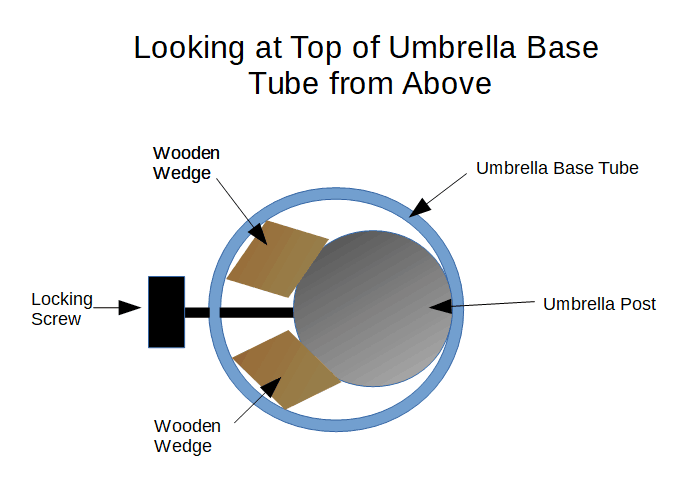
If your Umbrella is able to spin in its base then it is not suitably attached. In most cases, this is due to either not using the locking mechanism (if there is one!) on your base or because the umbrella pole is much smaller than the base tube. You can easily avoid this happening by wedging pieces of wood down alongside the post. (Or buy a reducer / cone (Amazon Link) as mentioned above) They need to be tight but be warned that it is possible to crack to the base tube if you wedge them too much!
TIP: I would always leave an inch or two of wood above the top of the base tube to help me remove the wedge for when packing away.
DIY In-Ground Post Mount
Cementing some pipe into the ground!
If you were setting a fence post or shade sail post into the ground then the recommended depth for the tube hole is 1/3 of the height above ground ie if the top of your umbrella is to be 6 foot above ground then your tube hole should be 2 ft into the ground. It should also be about 12″ wide at the top and ideally a little wider at the bottom (bell-shaped).
NOTE: If you’re in the US, remember to always call ‘811’ before any project involving digging. Its a completely FREE service and they can help you pinpoint the areas you should not dig in. (You then have the information for any DIY projects you might do in your yard)
The depth of your tube does not mean your umbrella has to be exceptionally long to allow for the extra depth! Indeed the suggestion is that you then use a short length of tube (the depth of your ‘footing tube’ + ~14″ above ground) to act the same as a base tube and then put your umbrella into that. You can then add locking screws to hold the umbrella and this insert can be removed leaving you a plain hole flush with your surface.
Why do Patio Umbrellas Blow Over?
For most people, sitting outside under a patio umbrella when the wind is blowing hard is not what they are after. There are a number of Patio Umbrellas that have been tested in wind tunnels that show they are capable of withstanding 100Km/hr winds, when still up! For most of us, this is of limited benefit, as I have no intention of sitting outside in such conditions.
The main reason people are frustrated with there umbrella blowing over is when it happens due to an unexpected gust of wind, not when it is blowing a regular hurricane.
Wind Strength: How Strong is Too Strong for Patio Umbrellas?
According to the National Weather Service (NOAA) in the USA they will announce a ‘Wind Advisory when sustained winds of 30 mph for one hour and/or frequent gusts of at least 45 mph are occurring or expected within the next 36 hours.’
Wind speeds are not constant – they are changing all the time. As explained by the MetService, if you measured the wind speed at one-second intervals, you would often get different measurements from second to second. When they discuss sustained winds it is actually the mean wind speed, which is given as the average of the wind speeds (Gusts and Lulls) over the last ten minutes.
- Gust: a brief increase in the strength of the wind, often only lasting a few seconds.
- Lull: a brief decrease in the strength of the wind, also usually only lasting a few seconds.
Beaufort scale; it relates wind speed to observable conditions from Force 0 where smoke rises vertically to Force 12 which is hurricane conditions above 73mph and causes devastation.
- Force 4: a Moderate Wind 20-28 Km/hr (~16mph) will cause small branches to move and lift dust or loose paper
- Force 5: a Fresh Wind 29-38 Km/hr (~22mph) will cause small trees to sway and flags would be fully extended
Using the Beaufort scale above I would suggest that gusts around 20-25 mph are about the maximum for sitting outside and indeed many automatic awnings are designed to be closed at that wind speed.
There are two areas that we can control to reduce the likelihood of the umbrella blowing away. We can increase its Stability and/or decrease its Windage.
Aerodynamics / Windage
The is the effect that the area and shape of the umbrella (its aerodynamics) has on how much force the wind can produce on it. Streamlining (Reducing) the surface area that is exposed to the wind will reduce the force that is experienced by the umbrella.
Umbrellas as big as a Sail!
When you consider the size of some of the Patio Umbrellas it really isn’t a surprise that they blow over. They are much bigger than most kites and when you compare them to the sail on a boat you can see how much power they can generate.
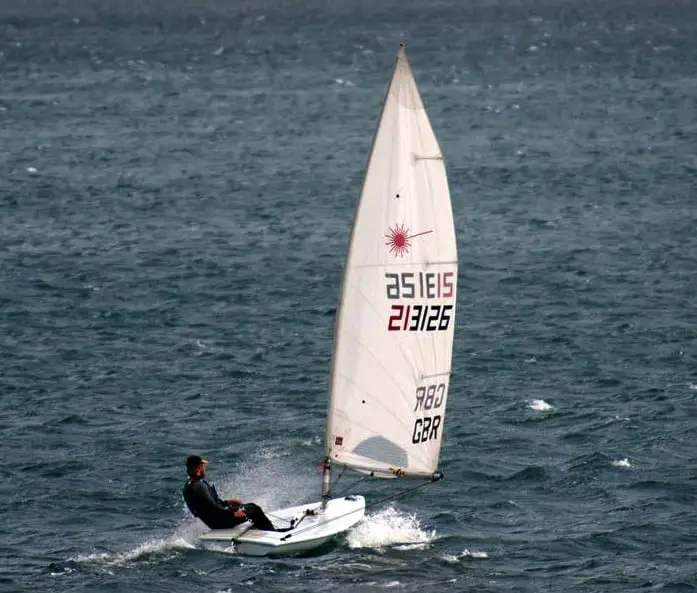
The top speed of a laser sailing dinghy with a single sail area of 76ft2 (7.06m2) that can take a 130lbs (60Kg) boat with a 170lbs skipper (80Kgs), totaling 300lbs (136Kg) at over 15mph (24Km/h) !
That’s a sail area smaller than a round, 10ft diameter, umbrella!
Obviously one is finely tuned aerodynamically to catch the wind and the other designed to withstand it but you shouldn’t underestimate the task involved.
The Aerodynamics of Adding Vents to your Umbrella
In many cases, it is the umbrella lifting up, and then becoming unstable, which actually causes it to topple over. Added vents can make a big difference to how umbrellas cope with windy conditions for two reasons:
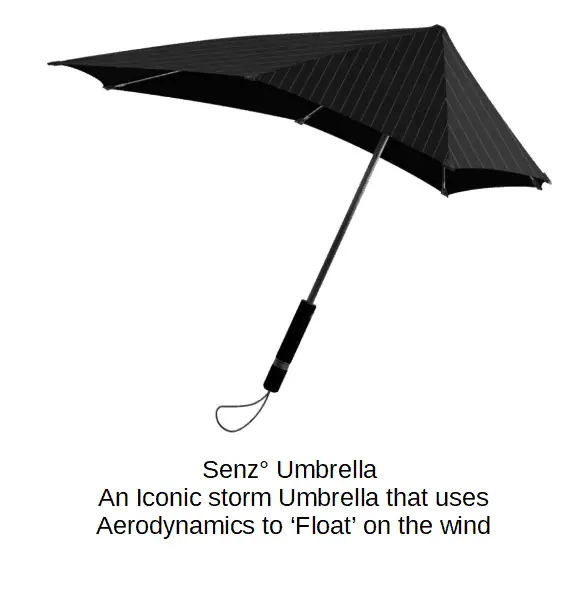
- The umbrella shape is very similar to that of an airplane wing and as such when the wind blows it causes the wind to change direction which creates lift! (NASA – Lift from flow)
- Adding vents reduces this lift as it reduces the air pressure difference above and below the canopy.
- Wind does not blow uniformly and as it gets stronger it can have a greater vertical component that can push the umbrella up or down.
- If the umbrella gets caught in an up-current then the vents act as holes, simply allowing some of the airflow to escape straight through the canopy.
(If you are interested in this Senz Umbrella!)
The more vents, the more the lift is reduced and the more airflow that can escape.
The additional benefit of the vents is that, on a still day, any build-up of hot air underneath the canopy will not get trapped as it can rise up through the vents.
Improved Aerodynamics by material
In most cases, the actual design of the canopy may not appear to be very different but the materials used in its construction can make a big difference. The strength and bending characteristics of the material to withstand the forces created can also affect its aerodynamics. The more the ribs can maintain the structure or recover having been deformed (bent) by the force the better your umbrella will cope.
Less is not always better!
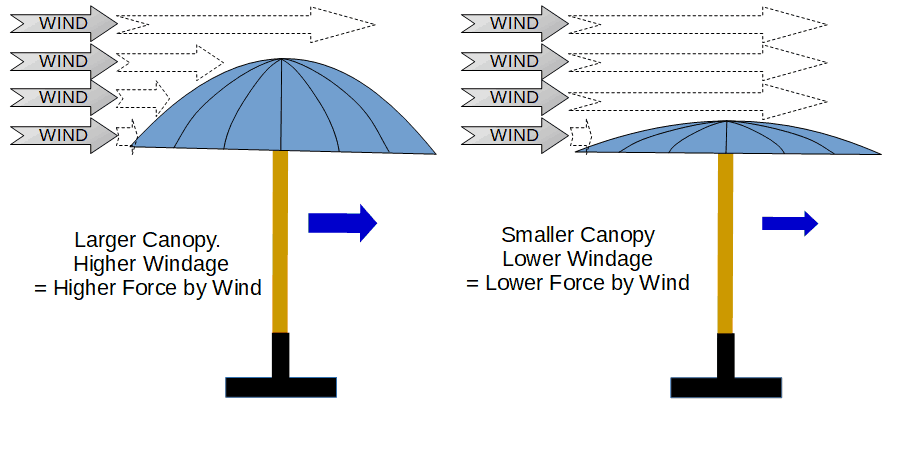
It is common sense that by reducing the amount of canopy, you will reduce the windage, your umbrella will experience less wind force and therefore be less likely to take off. That is true, unless, the force of the wind is actually helping you!
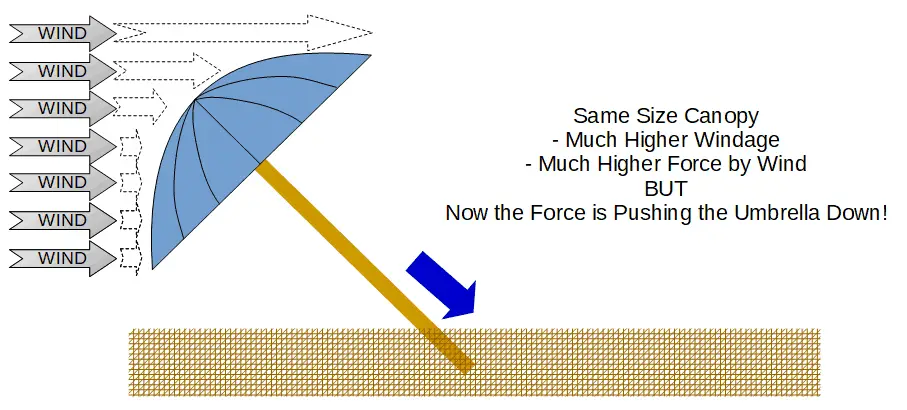
If you have your umbrella angled into the wind (with the top of the canopy facing the wind) then the force of the wind may actually help push the umbrella down.
Note: This is only really appropriate for beach umbrellas where the whole post can be angled as opposed to patio umbrellas which may only have a tilting top.
Why Tilting your Patio Umbrella Doesn’t help in a Breeze
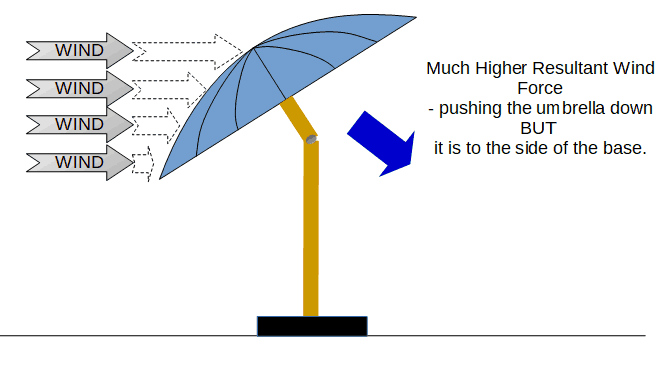
When you tilt the top of your Patio Umbrella towards the wind, the wind force will indeed help to push it down, instead of just horizontally. However, it is still pushing it down to the outside of the base, so it is still inclined to topple. When you then also consider all the extra windage, meaning the wind force is now much greater, it is not a good idea to tilt your Patio umbrella when it is windy.
How Umbrella Stability can be improved.
Not wanting to go ‘back to school’ but the more ‘stable’ your umbrella, the higher the force that is required to make it fall over.
We have already decided that we are not too concerned about sustained wind strength, as we will already be inside when it is too strong. However, for the gusts, we still want our umbrella to perform and that is decided by its stability.
There are two stability factors that you can consider in order to stop your umbrella from blowing away:
- The lower the center of gravity, the more stable the object
- The larger the base area of the object, the more stable the object.
The Science of it.
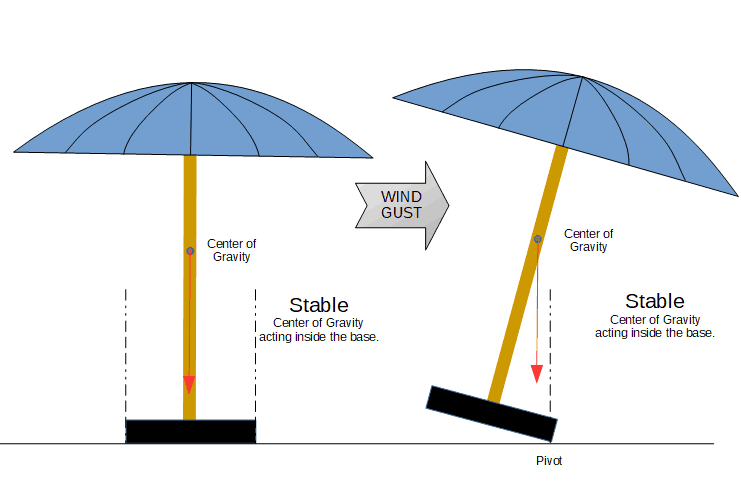
All of the Umbrellas weight can be considered to be acting through the Center of Gravity. When this is inside the ‘footprint’ of the base (following a small gust) it is stable and will return to being upright when pushed.
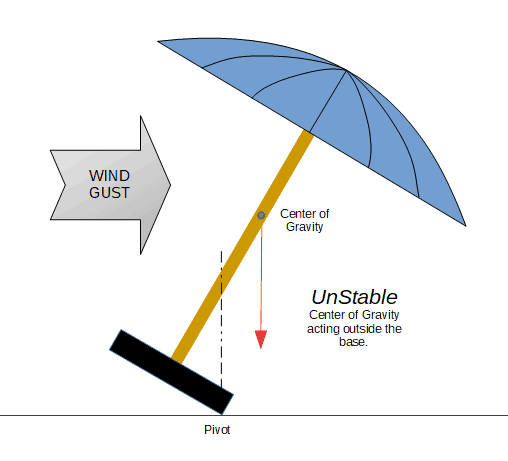
If the weight of the Umbrella acts outside the base (following a stronger gust) then it will cause a turning effect that will make the umbrella topple over.
Factor 1: Lowering the Center Of Gravity
Method 1: Adding weight to its base
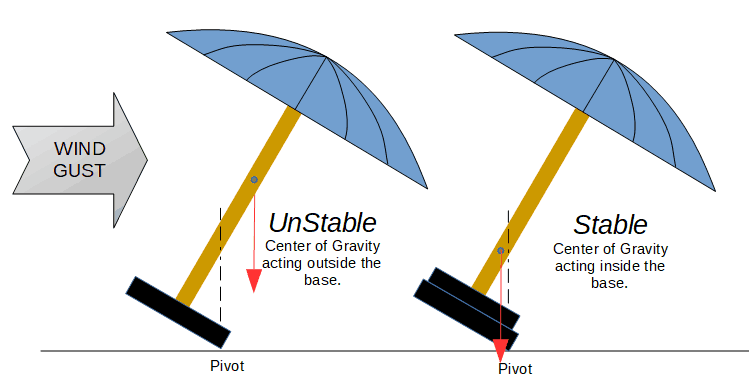
This is the most common and easiest method for making the umbrella more stable. By making the base heavier you can very quickly lower its center of gravity. This can either mean buying a heavier base (you should also be considering a wider or fixed version) or adding weight to the top of the existing base.
Method 2: Reducing its weight
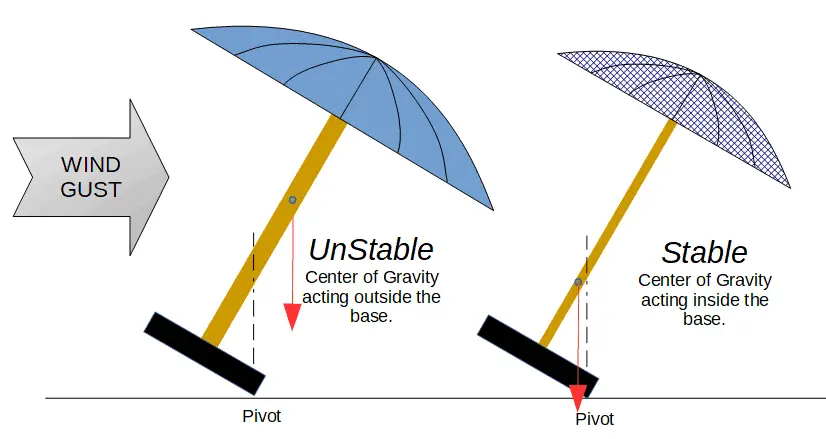
Reducing the weight of the Umbrella will lower the Center of Gravity if you use the same base. This will usually mean a smaller diameter Umbrella but some weight reduction can also be made by changing the construction materials eg from aluminum to wood. You need to consider if it is also reducing the strength of the umbrella. Some of the aluminum struts and hubs used on the larger umbrellas are needed to give the strength required to hold the long ribs/struts in the wind.
Method 3: Reducing its height.
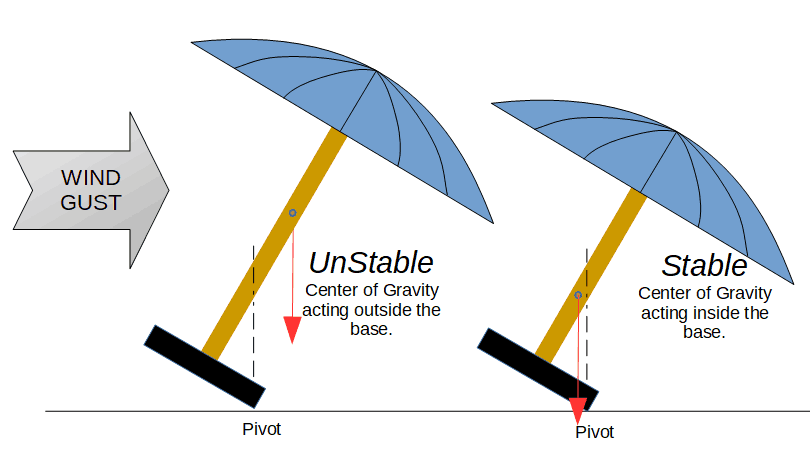
Reducing the height for a patio umbrella literally means making the post/pole height smaller so that the main weight (the canopy, hub and ribs/struts) of the umbrella is nearer the ground. This could be by cutting the bottom off of the pole (!) or more likely considering the height of the umbrella you buy.
When sitting underneath a pool umbrella (as opposed to one for a table) then selecting a shorter model may still be practical and will increase its stability. Larger umbrellas, particularly if designed for the middle of a table, tend to also be taller, to allow them enough clearance for the struts when the umbrella is down. It may therefore not be practical to reduce its height.
Factor 2: Larger Base Area
Most people forget how much the dimensions of their base can significantly affect the overall stability.
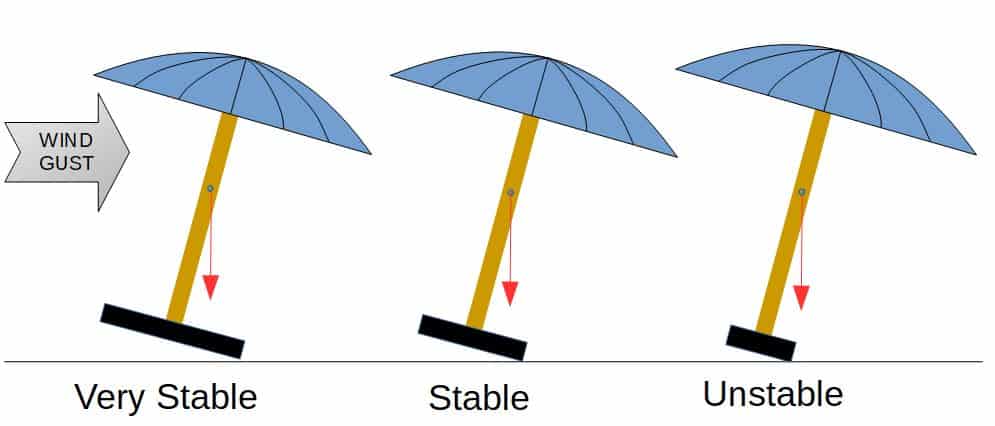
The larger the base area of the object, the more stable the object.
The size of the base is usually limited by the location and the practical inconvenience of having large heavy structures under a table or in the middle of a patio.
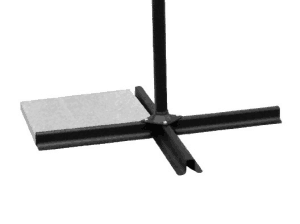
To combat this, some bases have been designed to sit underneath paving slabs so they might be incorporated into a patio, where they also utilize the weight of the paving slab.
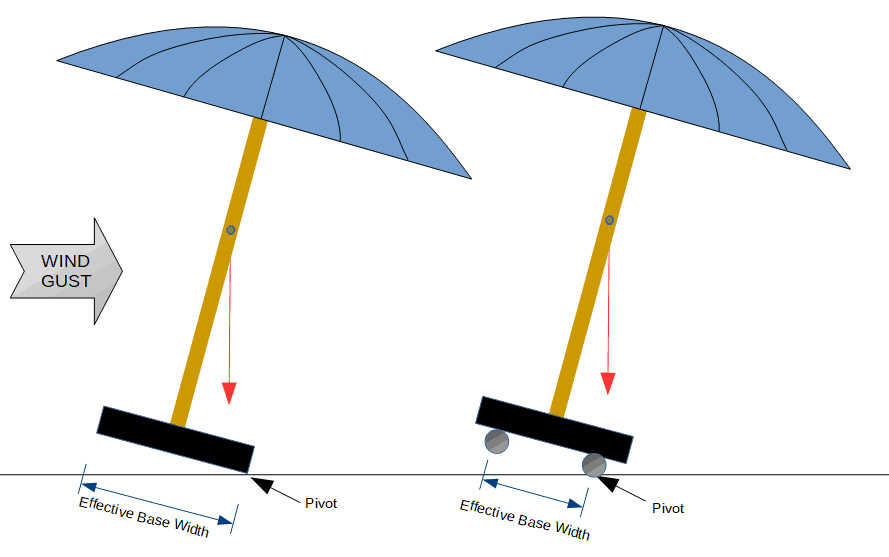
Is your base really that big?
When comparing, you need to consider how wide the base is from where it will pivot, not just its total width. Some bases have handy wheels underneath to make moving them easier but they may also reduce the effective width of the base.
If you are buying a new base then looking for a wider base (as well as heavier) would give you a double advantage.
Ultimately, if it is still getting blown over then maybe you need to try an alternative form of shade that is less susceptible to the wind, such as a properly installed shade sail or a pergola.
Check out How to Install a Shade Sail or Pergola Shade: Practical Cover Solutions for Any Outdoor Space.
